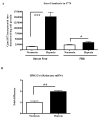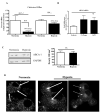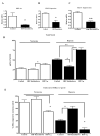Hypoxia is present in murine atherosclerotic plaques and has multiple adverse effects on macrophage lipid metabolism
- PMID: 21921268
- PMCID: PMC3208906
- DOI: 10.1161/CIRCRESAHA.111.246363
Hypoxia is present in murine atherosclerotic plaques and has multiple adverse effects on macrophage lipid metabolism
Abstract
Rationale: Human atherosclerotic plaques contain large numbers of cells deprived of O(2). In murine atherosclerosis, because the plaques are small, it is controversial whether hypoxia can occur.
Objective: To examine if murine plaques contain hypoxic cells, and whether hypoxia regulates changes in cellular lipid metabolism and gene expression in macrophages.
Methods and results: Aortic plaques from apolipoprotein-E-deficient mice were immunopositive for hypoxia-inducible transcription factor (HIF-1α) and some of its downstream targets. Murine J774 macrophages rendered hypoxic demonstrated significant increases in cellular sterol and triglycerides. The increase in sterol content in hypoxic macrophages correlated with elevated 3-hydroxy-3-methyl-glutaryl-CoA (HMG-CoA) reductase activity and mRNA levels. In addition, when macrophages were incubated with cholesterol complexes, hypoxic cells accumulated 120% more cholesterol, predominately in the free form. Cholesterol-efflux assays showed that hypoxia significantly decreased efflux mediated by ATP-binding cassette subfamily A member 1 (ABCA1), whose sub cellular localization was altered in both J774 and primary macrophages. Furthermore, in vivo expression patterns of selected genes from cells in hypoxic regions of murine plaques were similar to those from J774 and primary macrophages incubated in hypoxia. The hypoxia-induced accumulation of sterol and decreased cholesterol efflux was substantially reversed in vitro by reducing the expression of the hypoxia-inducible transcription factor, HIF-1α.
Conclusion: Hypoxic regions are present in murine plaques. Hypoxic macrophages have increased sterol content due to the induction of sterol synthesis and the suppression of cholesterol efflux, effects that are in part mediated by HIF-1α.
Figures








Similar articles
-
Hypoxia in murine atherosclerotic plaques and its adverse effects on macrophages.Trends Cardiovasc Med. 2013 Apr;23(3):80-4. doi: 10.1016/j.tcm.2012.09.004. Epub 2013 Feb 1. Trends Cardiovasc Med. 2013. PMID: 23375596 Free PMC article. Review.
-
MicroRNA-19b promotes macrophage cholesterol accumulation and aortic atherosclerosis by targeting ATP-binding cassette transporter A1.Atherosclerosis. 2014 Sep;236(1):215-26. doi: 10.1016/j.atherosclerosis.2014.07.005. Epub 2014 Jul 18. Atherosclerosis. 2014. PMID: 25084135
-
Hypoxia-Inducible Factor-1α Expression in Macrophages Promotes Development of Atherosclerosis.Arterioscler Thromb Vasc Biol. 2016 Sep;36(9):1782-90. doi: 10.1161/ATVBAHA.116.307830. Epub 2016 Jul 21. Arterioscler Thromb Vasc Biol. 2016. PMID: 27444197
-
Regulation of macrophage cholesterol efflux through hydroxymethylglutaryl-CoA reductase inhibition: a role for RhoA in ABCA1-mediated cholesterol efflux.J Biol Chem. 2005 Jun 10;280(23):22212-21. doi: 10.1074/jbc.M502761200. Epub 2005 Apr 6. J Biol Chem. 2005. PMID: 15817453
-
Cholesterol and HIF-1α: Dangerous Liaisons in Atherosclerosis.Front Immunol. 2022 Mar 21;13:868958. doi: 10.3389/fimmu.2022.868958. eCollection 2022. Front Immunol. 2022. PMID: 35386720 Free PMC article. Review.
Cited by
-
Endothelial Barrier Function and Leukocyte Transmigration in Atherosclerosis.Biomedicines. 2021 Mar 24;9(4):328. doi: 10.3390/biomedicines9040328. Biomedicines. 2021. PMID: 33804952 Free PMC article. Review.
-
Immunometabolism in atherosclerotic disorders.Nat Cardiovasc Res. 2024 Jun;3(6):637-650. doi: 10.1038/s44161-024-00473-5. Epub 2024 May 23. Nat Cardiovasc Res. 2024. PMID: 39196223 Review.
-
Atherosclerotic plaque targeting mechanism of long-circulating nanoparticles established by multimodal imaging.ACS Nano. 2015 Feb 24;9(2):1837-47. doi: 10.1021/nn506750r. Epub 2015 Jan 28. ACS Nano. 2015. PMID: 25619964 Free PMC article.
-
Causal relationship between nonalcoholic fatty liver disease and different sleep traits: a bidirectional Mendelian randomized study.Front Endocrinol (Lausanne). 2023 Jun 2;14:1159258. doi: 10.3389/fendo.2023.1159258. eCollection 2023. Front Endocrinol (Lausanne). 2023. PMID: 37334291 Free PMC article. Clinical Trial.
-
Inflammatory processes in cardiovascular disease: a route to targeted therapies.Nat Rev Cardiol. 2017 Mar;14(3):133-144. doi: 10.1038/nrcardio.2016.185. Epub 2016 Dec 1. Nat Rev Cardiol. 2017. PMID: 27905474 Free PMC article. Review.
References
-
- Davidson MH. Overview of prevention and treatment of atherosclerosis with lipid-altering therapy for pharmacy directors. Am J Manag Care. 2007;13(Suppl 10):S260–269. - PubMed
-
- Mensah GA, Brown DW. An overview of cardiovascular disease burden in the united states. Health Aff (Millwood) 2007;26:38–48. - PubMed
-
- Levin M, Leppanen O, Evaldsson M, Wiklund O, Bondjers G, Bjornheden T. Mapping of atp, glucose, glycogen, and lactate concentrations within the arterial wall. Arterioscler Thromb Vasc Biol. 2003;23:1801–1807. - PubMed
-
- Bjornheden T, Levin M, Evaldsson M, Wiklund O. Evidence of hypoxic areas within the arterial wall in vivo. Arterioscler Thromb Vasc Biol. 1999;19:870–876. - PubMed
-
- Leineweber C, Kecklund G, Janszky I, Akerstedt T, Orth-Gomer K. Snoring and progression of coronary artery disease: The stockholm female coronary angiography study. Sleep. 2004;27:1344–1349. - PubMed
Publication types
MeSH terms
Substances
Grants and funding
LinkOut - more resources
Full Text Sources
Medical
Molecular Biology Databases

